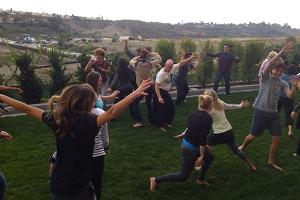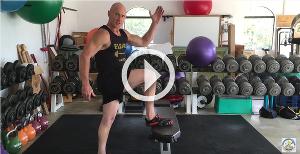7 Ways to Become a Better Trainer: Part 2
by Paul Chek

Last week in Part 1 of my mini-series on 7 Ways to Become a Better Trainer, I offered three related tips: Trainers are leaders, Lead by example, and Your first example must be to yourself.
In Part 2, I’m going to focus on something a little different — having a dream. As you’ll see having a clearly defined dream can really transform your practice.
And by the way, these techniques are powerful for creating the life you want whoever you are and whatever your profession is now, so don’t stop here even if you’re not a trainer and don’t want to be one!
Have Clearly Defined Dreams
 If you are living the life of your dreams, you will seldom, if ever, hear yourself uttering the words, “I wish I had,” “I wish I were,” or “I wish I could.”
If you are living the life of your dreams, you will seldom, if ever, hear yourself uttering the words, “I wish I had,” “I wish I were,” or “I wish I could.”
Words like those are unnecessary if you have a clearly defined dream because you are fully aware you are realizing it one day at a time.
What’s more, each day, you are living more of your dream than you were yesterday. Thus, your life becomes a source of perpetual satisfaction and a wonderful adventure, and one you can share as an example to your clients today and tomorrow.
So, what is your dream?
Have Goals
Creation always happens in three phases:
1. Thoughts – Think them through.
Having goals that plot steps to achieve your personal and professional dreams is to create a thought-body. It’s like a film negative that attracts the necessary atoms and molecules with which to create its body (your goals) in tangible reality.
2. Words – Write them down or share them with mentors who can help you bring them to fruition.
Thoughts transition into tangible reality through the vibration of words as spoken language or through the symbology of written language. When you speak, you lower the vibration of a thought to the point that it can be felt.
Through the act of consciousness and transforming thoughts into words, you go a step further toward creating your dreams tangibly.
When you write down your goals, you immediately attract physical matter to them in the form of ink to paper. Not many builders work without a blueprint!
3. Deeds – Take action to build a body around your creation!
It’s critical to structure your goals carefully to ensure they are realistic. Many of the C.H.E.K Practitioners I mentor start by telling me, “I don’t have goals because I never seem to achieve them. That’s depressing, so I just quit writing them down.”
This is also a common response from my clients. When I ask them to write their goals down, after analyzing them, inevitably, I find that they are unrealistic based on their available time, energy and financial ability.
If you want to write effective goals, work with what you have and allow yourself the time you need to do what you can so that you can experience regular rewards. After all, it is always better to under-promise and over-deliver than it is to over-promise and under-deliver!
When writing down your goals, always be sure to include these things:
- Separate personal goals from professional goals even if they accomplish common objectives. This way, you can more carefully allot time in your schedule for each objective to be met, increasing your chances of experiencing regular rewards.
- Include time for your personal development. Don’t forget to ask yourself, how much time you need to sleep each night, exercise each day/week, spend time with your loved ones and friends and contribute to your community or social groups.
When considering how to invest time in your professional development, it’s important to consider these questions:
- How much education do you need to achieve your goals?
- Which educators are living examples of their teachings and are more likely to give you the best return on your financial and time investment, moving you rapidly to your goals?
- Where do you need the most help? For example, I use my own goal structure to work on physical, emotional, mental, spiritual, theoretical, practical and conceptual areas.
Manage Your Stress Levels
 When you have the courage to pursue your dreams, build a carefully staged goal structure and manage your self, you will experience an immediate reduction in your stress levels and an immediate increase in your energy levels.
When you have the courage to pursue your dreams, build a carefully staged goal structure and manage your self, you will experience an immediate reduction in your stress levels and an immediate increase in your energy levels.
Unfortunately, about 97 percent of the human population fails to take these steps! If you’ve taken the steps outlined here and you still find yourself suffering from more stress than you feel is healthy or normal, you will need more training to understand its origins.
I have a very nicely distilled chapter on stress in my book, How to Eat, Move and Be Healthy! This book also provides very effective tools for determining the best ratio of animal to vegetable foods for your personal needs, how much water you should drink each day, which exercises will best aid in energy accumulation as well as other methods to assist you in effectively managing your self.
Enjoy the Journey! Don’t Wait Until You’ve Made It!

It’s very common for me to hear clients/patients and students saying, “When I get my fill-in-the-blank, I’ll enjoy a nice vacation,” or “I’ll take some time to go to school and learn about what I really want to do” or “I’ll go on that retreat”.
That isn’t living… That’s waiting to live!
The fact is, there’s really nothing but the now. Yesterday is gone, and tomorrow may never come! You can imagine a victim of Hurricane Katrina telling their friend just before the storm struck, “As soon as I get time, I’ll go visit my mother in California,” only to lose their life in the storm.
We are not human-tomorrows or human-yesterdays. We are human beings. That implies being, being here now, doing now, living now.
Surely, we all have many things we wish we were doing, but wishing is not doing. Choose what activities you want to experience while you are here as a human being. These are your dreams.
Prioritize and structure these goals realistically, then begin living them immediately and you will wake up each day with tremendous joy. And that’s really living!
What an amazing gift you will give humanity if you just do that.
Love and chi,
Paul


